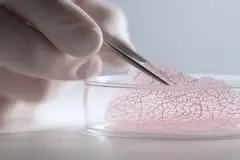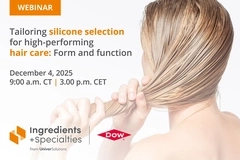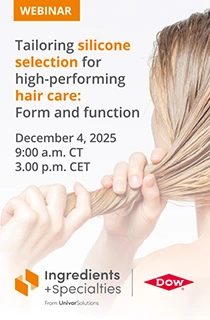NIH organoid center to aid regulatory and industry acceptance of cruelty-free cosmetics testing
Key takeaways
- NIH’s new SOM Center will develop standardized organoid models that could replace animal tests.
- Open-access protocols may make safety testing cheaper and more reliable for cosmetics companies.
- Animal welfare advocacy groups say standardization could speed up regulatory approval for cruelty-free methods.
The National Institutes of Health (NIH) is opening a “first of its kind” Standardized Organoid Modeling (SOM) center that will influence how beauty companies test products by providing standardized, cruelty-free alternatives to animal testing.
The center is designed for biomedical research but will directly benefit personal care companies seeking animal-free safety testing.
Personal Care Insights speaks with experts from the NIH and animal welfare advocacy groups PETA and Cruelty Free International about how the US$87M-funded center could make it easier for cosmetics companies to choose non-animal testing strategies by creating a standardized system.
“The NIH SOM Center is designed to accelerate the development, validation, and broad adoption of organoid technologies as human-relevant tools,” Dr. Nicole Kleinsteuer, acting NIH deputy director for program coordination, planning, and strategic initiatives, tells us.
Organoid systems are miniature, lab-grown tissue models that replicate the structures and functions of human organs. They can help assess how ingredients are metabolized and what potential effects they could have on human health.
However, most organoids are currently developed in academic settings through trial-and-error approaches, which limit reproducibility and slow broader adoption across laboratories.
“Organoids hold fantastic potential in helping the cosmetics industry transition away from animal testing, whether in the R&D phase or for regulatory-required testing for safety purposes,” says PETA science advisor, Dr. Janneke Hogervorst.
Monica Engebretson, head of public affairs for North America at Cruelty Free International, adds that organoids of skin, eye, liver, and other tissues are directly relevant to safety assessments needed in cosmetics.
“Most cosmetics companies recognize that consumers care deeply about using products that are not tested on animals. With growing investment in non-animal testing methods and increasing regulatory acceptance, it will be easier than ever for companies to meet consumer demand for innovative, cruelty-free products,” Engebretson tells us.
“By making these models more reliable, scalable, affordable, and acceptable to regulators, the SOM Center could help companies in [the personal care sector] move further away from animal testing.”
.webp) NIH’s new SOM Center will develop standardized organoid models that could replace animal tests.Stuck on standardization
NIH’s new SOM Center will develop standardized organoid models that could replace animal tests.Stuck on standardization
Over the past few years, scientific innovation in personal care testing has highlighted the efficacy of new approach methodologies (NAMs). These methodologies are designed to reduce, refine, or replace animal testing in risk assessments.
However, entirely replacing animal methods with NAMs is claimed to be challenging due to a lack of standardized protocols, uneven regulatory acceptance, and reproducibility issues.
Engebretson says: “Any center that is working to standardize a NAM is a good thing for everyone, especially since standardization is often highlighted as a key barrier. Without agreed protocols, results can vary from one lab to another, making regulators less confident in the data and companies less willing to rely on the methods.”
The SOM Center is in its initial phase of developing liver and intestinal models with standardized protocols. The NIH says it is too early to provide a firm timeline for when cosmetics companies can expect to use them.
However, the NIH does note that the center aims to generate and share validated reference protocols over the next few years.
“We expect that as methods mature, cosmetics and personal care companies will be able to incorporate [standardized protocols] into their ingredient safety programs, either directly or through partnerships with contract research laboratories,” says Kleinsteuer.
PETA’s Hogervorst explains that the organoid models could eventually be included in Organisation for Economic Co-operation and Development (OECD) Test Guidelines or ISO standards, the international rulebooks that make methods globally accepted for regulatory use.
“Standardization is often the key that unlocks regulatory confidence. When a test has the same inputs, steps, and performance checks across laboratories, regulators can judge reliability and compare results,” she says.
Driving down testing costs
Beyond developing new organoid models, the NIH stresses that the SOM Center will openly share its protocols and data.
.webp) Open-access protocols may make organoid testing cheaper and more reliable for cosmetics companies.“A central feature of the SOM Center is a commitment to transparency and community adoption. Protocols, data, and reference materials developed by the center will be shared broadly with the scientific community,” says Kleinsteuer.
Open-access protocols may make organoid testing cheaper and more reliable for cosmetics companies.“A central feature of the SOM Center is a commitment to transparency and community adoption. Protocols, data, and reference materials developed by the center will be shared broadly with the scientific community,” says Kleinsteuer.
“This open-access approach is intended to reduce barriers to entry and ensure that stakeholders, including cosmetics ingredient makers and testing labs, can benefit from the SOM Center’s work without duplicative investment.”
Efficacy of adoption
The cosmetics industry has already adopted numerous organoid systems to improve the efficacy of cosmetics.
“Skin organoids are already transforming how we study aging, and human hair follicle organoids open new doors for understanding hair loss — both areas that have traditionally relied on crude experiments on mice,” Hogervorst says.
Last week, South Korea’s Cosmax reported its use of organoid research led to new insights into the biological process behind hair greying, where knowledge was previously limited to animal studies.
Brain organoids reveal how substances influence the nervous system and can uncover toxic effects that tests on animals often miss, Hogervorst explains. Meanwhile, testicular organoids help study how chemicals affect reproduction.
However, Hogevorst argues that some markets have a grey area in enforcement. Some mandate animal testing for chemicals but prohibit animal testing for finalized products.
.webp) Animal welfare advocacy groups say standardization could speed up regulatory approval for cruelty-free methods.Organoids could help fill these gaps by producing detailed, human-relevant information on how ingredients behave in the body. This would enable regulators to make informed safety decisions without relying on animal data.
Animal welfare advocacy groups say standardization could speed up regulatory approval for cruelty-free methods.Organoids could help fill these gaps by producing detailed, human-relevant information on how ingredients behave in the body. This would enable regulators to make informed safety decisions without relying on animal data.
Legal loopholes
The NIH’s move comes as Europe faces pressure to defend its own cruelty-free commitments. Lawmakers and NGOs have warned that upcoming revisions to REACH and the Cosmetics Products Regulation could weaken the EU’s 2013 ban on cosmetic animal testing.
“While the Cosmetics Regulation rightly bans the sale of cosmetics tested on animals — a landmark ethical achievement — REACH still permits animal testing for worker safety assessments of cosmetic ingredients,” explains Hogervorst.
“This contradiction not only keeps animals trapped in laboratories, suffering and dying in toxicity tests, but also undermines consumer trust.”
To resolve this, Hogervorst tells us REACH and other similar legislation worldwide must mandate the use of existing non-animal safety data for cosmetics and expedite the development and acceptance of non-animal methods for environmental safety assessments.
In response to the EU’s regulatory mismatch, PETA tightened its Beauty Without Bunnies program. It now only lists companies that sell in countries where such grey areas do not apply.
The group said the step was necessary to protect consumers from misleading cruelty-free claims and push regulators toward closing gaps in legislation.
Hogervorst concludes: “People overwhelmingly prefer a product to be withdrawn from sale rather than tested on animals, yet this loophole robs them of confidence when choosing cruelty-free brands.”














